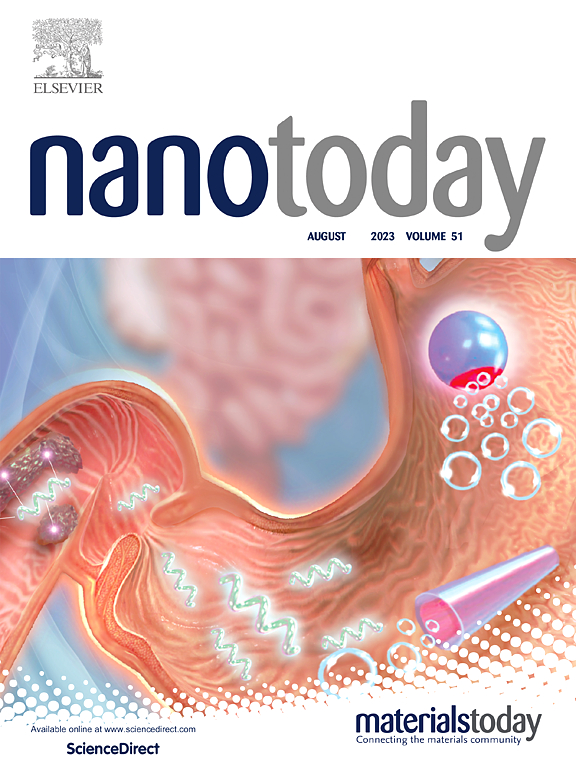A nuclei bombing nano-system improves STING-activated cancer immunotherapy
IF 10.9
1区 材料科学
Q1 CHEMISTRY, MULTIDISCIPLINARY
引用次数: 0
Abstract
The activation of the stimulator of interferon genes (STING) pathway presents a promising therapeutic strategy for pancreatic cancer by enhancing immune responses and reprogramming the immunosuppressive tumor microenvironment (TME). Ferroptosis, an iron-dependent form of cell death, can synergize with STING activation through reactive oxygen species (ROS)-induced DNA damage. However, its efficacy is hindered by poor vascularization, inefficient delivery of STING agonists, and tumor resistance mechanisms that suppress ROS levels. To overcome these limitations, we developed a "nuclei bombing" nano-system using extremely small cuprous oxide modified magneto-human heavy chain ferritin (ES-CO@M-HFn). This system targets pancreatic cancer cells overexpressing transferrin receptor 1 (TfR1) and releases Cu+ and Fe3+ ions in response to the acidic (pH 6.8) and glutathione (GSH)-rich TME. These ions form a Cu-Fe catalytic cycle under high H₂O₂ levels, continuously generating Fe2+, Cu+, and robust ROS, thereby inducing ferroptosis and cuproptosis. This creates a synergistic feedback loop that amplifies oxidative damage, leading to extensive DNA damage and tumor cell destruction—termed the "nuclei bombing" effect. The resulting DNA fragments activate the STING pathway, reprogramming the TME by maturing dendritic cells, repolarizing macrophages, and activating CD8+ T cells. This comprehensive approach generates a potent immune response, significantly suppressing tumor growth and metastasis, and offers a transformative strategy for pancreatic cancer treatment.
核轰炸纳米系统改善了针刺激活的癌症免疫治疗
干扰素基因刺激因子(STING)通路的激活通过增强免疫应答和重新编程免疫抑制肿瘤微环境(TME),为胰腺癌的治疗提供了一种有前景的治疗策略。铁死亡是一种依赖铁的细胞死亡形式,可通过活性氧(ROS)诱导的DNA损伤与STING激活协同作用。然而,其疗效受到血管化不良、STING激动剂递送效率低下以及抑制ROS水平的肿瘤耐药机制的阻碍。为了克服这些限制,我们开发了一种“核轰炸”纳米系统,使用极小的氧化亚铜修饰磁人重链铁蛋白(ES-CO@M-HFn)。该系统针对过表达转铁蛋白受体1 (TfR1)的胰腺癌细胞,并释放Cu+和Fe3+离子,以响应酸性(pH 6.8)和谷胱甘肽(GSH)丰富的TME。这些离子在高H₂O₂水平下形成Cu- fe催化循环,不断生成Fe2+、Cu+和强大的ROS,从而诱导铁下垂和铜下垂。这就产生了一个协同反馈循环,放大了氧化损伤,导致广泛的DNA损伤和肿瘤细胞破坏——被称为“核轰炸”效应。由此产生的DNA片段激活STING通路,通过成熟树突状细胞、巨噬细胞再极化和激活CD8+ T细胞对TME进行重编程。这种综合的方法产生有效的免疫反应,显著抑制肿瘤生长和转移,并为胰腺癌治疗提供了一种变革性的策略。
本文章由计算机程序翻译,如有差异,请以英文原文为准。
求助全文
约1分钟内获得全文
求助全文
来源期刊

Nano Today
工程技术-材料科学:综合
CiteScore
21.50
自引率
3.40%
发文量
305
审稿时长
40 days
期刊介绍:
Nano Today is a journal dedicated to publishing influential and innovative work in the field of nanoscience and technology. It covers a wide range of subject areas including biomaterials, materials chemistry, materials science, chemistry, bioengineering, biochemistry, genetics and molecular biology, engineering, and nanotechnology. The journal considers articles that inform readers about the latest research, breakthroughs, and topical issues in these fields. It provides comprehensive coverage through a mixture of peer-reviewed articles, research news, and information on key developments. Nano Today is abstracted and indexed in Science Citation Index, Ei Compendex, Embase, Scopus, and INSPEC.
 求助内容:
求助内容: 应助结果提醒方式:
应助结果提醒方式:


